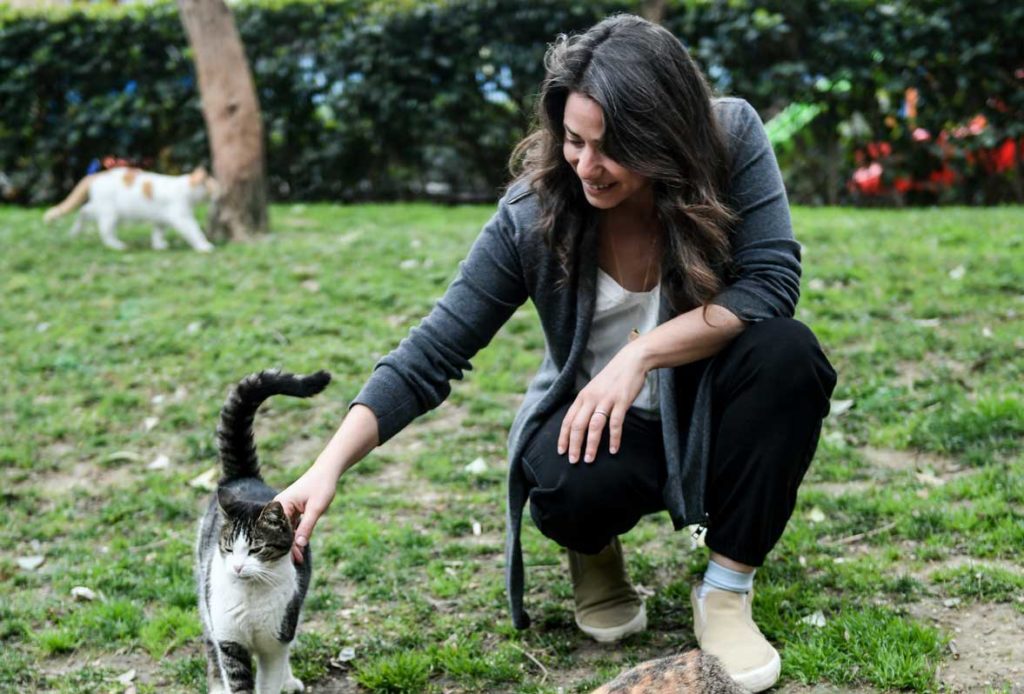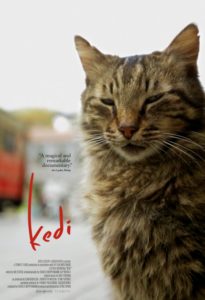
“Dogs think people are God, but cats don’t. Cats are aware of God’s existence. Cats know that people act as middlemen to God’s will. They’re not ungrateful, they just know better.” Thus declares one of the humans in Ceyda Torun‘s documentary Kedi (watch the trailer below), a poignant portrait of Istanbul’s street cats.
Torun, who grew up in Istanbul, has described Kedi as “a love letter” to those cats and her hometown. In it, we see not only adorable felines, but also how they warm the hearts of humans around them. Cat’s aren’t just cute; they’re therapeutic. As another one of the film’s humans says: “a cat meowing at your feet, looking up at you, is life smiling at you.”
With cats dominating the internet, it’s no surprise that Kedi (Turkish for “cat”) has picked up quite a bit of buzz — not to mention dozens of screenings at theaters all across North America. Besides, who wouldn’t want to watch what essentially is a 79 minute high quality cat video?
Cinema Escapist had the chance to talk with Torun and learn more about her experiences directing Kedi and chasing after its feline subjects. Read on!
• • •

What inspired you to make Kedi?
My love of the street cats of Istanbul — who were genuinely my best friends growing up there during my childhood days — fueled my passion to make the film. However, it was also a wonderful way to explore the city of Istanbul and its people through a different lens. I was keen to document the city of my birth in a much more honest way than how it is seen in news reports or tour guides.
How difficult was it to get Kedi off the ground? Did the burgeoning popularity of cats as an internet phenomenon help make finding financing or other forms of support easier at all?
The fact that people have been obsessed with cats online had absolutely everything to do with getting the film made! The cat renaissance of the last 5-10 years was the main proof — along with being able to point out just how many cats reside in homes around the world — that allowed us to convince financiers to take a leap of faith with this film. Luckily we weren’t wrong!
Kedi has quite a few shots at “cat eye level”, which I’m guessing involved a lot of human crouching. I was also impressed by one scene where we see a cat hunting for mice at night. Can you talk about the logistics involved in filming cats, given their highly mobile and independent nature?

It took us multiple tries, and multiple rigs, to figure out how best to film the cats. We had remote controlled cars that we fitted with cameras, but the cats didn’t like the whining noise of the tiny engine. We had harnesses made to hold tiny cameras, but cats would simply sit or lay down if we got one on them; besides, it would have been too costly to lose a camera because it’s often impossible to keep tabs on a cat in the city!
In the end, Charlie and Alp (Kedi’s cinematographers) created a camera rig where they could mount the Canon 5D MarkIIIs with monitors on a platform and have a very long handle from which they could manipulate focus. That allowed them to film the cats simply by walking alongside them, and by having two cameras on the cats at all times, we were able to capture continuous motion.
The cat hunting scene was captured with a motion activated, night vision camera that hunters use, that we locked into the grate above the sewer and left there over multiple nights. We were very lucky to get that footage!
How much total “cat footage” did you end up shooting?
We came home with 180 hours of footage, which I’m told is not too much for documentaries but it was still quite a lot!
Kedi not only features seven main street cats, but also various humans whose lives have been shaped by these feline companions. How did you choose which cats and humans to focus on… did you pick humans first and then cats? Cats and then humans? A mix?

It was mostly street casting — we’d walk around and strike up conversations with anyone who we saw interacting with cats.
We also interviewed “famous” Turks who are involved with cats in their art or work, but the cat stories are from people who we met as we walked around the neighborhoods of Istanbul.
We had leads to 35 cat stories before we began filming, we ended up filming 19, and only seven made it into the film.
Were there any cat stories that you really wish made it into the film, but didn’t?
Absolutely! There were so many, it’s hard to list them all. But I’m happy to say that there are a few stories that are making it into the DVD extra.
I’ve heard there are Facebook pages and even bronze statues dedicated to Istanbul street cats… just how big of a phenomenon are they in the city?
They’re quite a big deal and have become a recognizable trait of the city by foreigners. There’s no one from Istanbul who doesn’t have the memory of cats in the city, and it goes back as many generations as possible.
Is there something in Istanbul’s character that makes it such a great breeding ground for human-cat interaction?

It’s a combination of factors.
The city has been home to fishing communities for over 7,000 years and, with fish and humans, come cats. It sits in a very critical geographical point through which people have traveled since we migrated out of Africa as a species and started farming and having cats in our lives.
Add to that the praise for cats in Islam, where stories of the Prophet Mohammed’s interactions with cats are a way for people to learn how to respect and love others.
Of course, Istanbul is also a major city where, like with other major cities, people are growing farther apart and becoming more alienated despite being in close proximity to one another. Being able to care for animals is a wonderful way to feel connected, loved and needed.

As Kedi shows, there’s many individual Istanbulites who dedicate their lives to helping street cats but, at the same time, increasing urbanization is making life for such cats more difficult. How much institutional or municipal government attention do Istanbul’s street cats get?
The [individual districts of Istanbul] differ in their approaches to how they support street animals, but overall there’s great effort being made.
Having said that, it is the people of the city who are the most involved guardians of the animals, and they motivate their municipalities to act in kind.
If I travel to Istanbul — where are the best places to cat-watch?
Cihangir is the best — it’s where Gamsiz lives! But nearly all areas of town will have street cats, and I’m happy to say it won’t just be cat watching…there’ll be a lot of petting and snuggling too!
Want to watch Kedi? Check out a list of screening locations/starting dates (there’s a lot) on the film’s website. Alternatively, you can pre-order the film in digital or DVD/Blu-Ray format.
Note: This interview has been edited for clarity and length.